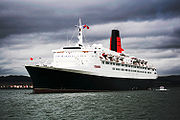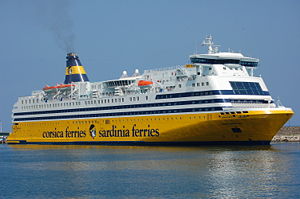
Passenger ship
Encyclopedia

Ship
Since the end of the age of sail a ship has been any large buoyant marine vessel. Ships are generally distinguished from boats based on size and cargo or passenger capacity. Ships are used on lakes, seas, and rivers for a variety of activities, such as the transport of people or goods, fishing,...
whose primary function is to carry passengers. The category does not include cargo vessels
Cargo ship
A cargo ship or freighter is any sort of ship or vessel that carries cargo, goods, and materials from one port to another. Thousands of cargo carriers ply the world's seas and oceans each year; they handle the bulk of international trade...
which have accommodations for limited numbers of passengers, such as the ubiquitous twelve-passenger freighters once common on the seas in which the transport of passengers is secondary to the carriage of freight. The type does however include many classes of ships designed to transport substantial numbers of passengers as well as freight. Indeed, until recently virtually all ocean liner
Ocean liner
An ocean liner is a ship designed to transport people from one seaport to another along regular long-distance maritime routes according to a schedule. Liners may also carry cargo or mail, and may sometimes be used for other purposes .Cargo vessels running to a schedule are sometimes referred to as...
s were able to transport mail, package freight and express, and other cargo in addition to passenger luggage, and were equipped with cargo holds
Hold (ship)
thumb|right|120px|View of the hold of a container shipA ship's hold is a space for carrying cargo. Cargo in holds may be either packaged in crates, bales, etc., or unpackaged . Access to holds is by a large hatch at the top...
and derricks, kingposts, or other cargo-handling gear for that purpose. Only in more recent ocean liner
Ocean liner
An ocean liner is a ship designed to transport people from one seaport to another along regular long-distance maritime routes according to a schedule. Liners may also carry cargo or mail, and may sometimes be used for other purposes .Cargo vessels running to a schedule are sometimes referred to as...
s and in virtually all cruise ship
Cruise ship
A cruise ship or cruise liner is a passenger ship used for pleasure voyages, where the voyage itself and the ship's amenities are part of the experience, as well as the different destinations along the way...
s has this cargo capacity been eliminated.
While typically passenger ships are part of the merchant marine, passenger ships have also been used as troopship
Troopship
A troopship is a ship used to carry soldiers, either in peacetime or wartime...
s and often are commissioned as naval ship
Naval ship
A naval ship is a ship used for combat purposes, commonly by a navy. Naval ships are differentiated from civilian ships by construction and purpose...
s when used as for that purpose.
Types

Ferry
A ferry is a form of transportation, usually a boat, but sometimes a ship, used to carry primarily passengers, and sometimes vehicles and cargo as well, across a body of water. Most ferries operate on regular, frequent, return services...
, which are vessels for day or overnight short-sea trips moving passengers and vehicles (whether road or rail); ocean liners, which typically are passenger or passenger-cargo vessels transporting passengers and often cargo on longer line voyages; and cruise ships, which often transport passengers on round-trips, in which the trip itself and the attractions of the ship and ports visited are the principal draw.
An ocean liner is the traditional form of passenger ship. Once such liners operated on scheduled line voyages to all inhabited parts of the world. With the advent of airliners transporting passengers and specialized cargo vessels hauling freight, line voyages have almost died out. But with their decline came an increase in sea trips for pleasure, and in the latter part of the 20th century ocean liners gave way to cruise ships as the predominant form of large passenger ship, with the main area of activity changing from the North Atlantic Ocean to the Caribbean Sea
Caribbean Sea
The Caribbean Sea is a sea of the Atlantic Ocean located in the tropics of the Western hemisphere. It is bounded by Mexico and Central America to the west and southwest, to the north by the Greater Antilles, and to the east by the Lesser Antilles....
.
Although some ships have characteristics of both types, the design priorities of the two forms are different: ocean liners value speed and traditional luxury while cruise ships value amenities (swimming pools, theaters, ball rooms, casinos, sports facilities, etc.) rather than speed. These priorities produce different designs. In addition, ocean liners typically were built to cross the Atlantic Ocean
Atlantic Ocean
The Atlantic Ocean is the second-largest of the world's oceanic divisions. With a total area of about , it covers approximately 20% of the Earth's surface and about 26% of its water surface area...
between Europe
Europe
Europe is, by convention, one of the world's seven continents. Comprising the westernmost peninsula of Eurasia, Europe is generally 'divided' from Asia to its east by the watershed divides of the Ural and Caucasus Mountains, the Ural River, the Caspian and Black Seas, and the waterways connecting...
and the United States
United States
The United States of America is a federal constitutional republic comprising fifty states and a federal district...
or travel even further to South America or Asia while cruise ships typically serve shorter routes with more stops along coastlines or among various islands.
For a long time cruise ships were smaller than the old ocean liners had been, but in the 1980s this changed when Knut Kloster, the director of Norwegian Caribbean Lines
Norwegian Cruise Line
Norwegian Cruise Line is a company operating cruise ships, headquartered in unincorporated Miami-Dade County, Florida. It began operations in 1966 under the name Norwegian Caribbean Line. The company is best known for its Freestyle Cruising concept, which means that there are no set times or...
, bought one of the biggest surviving liners, the SS France
SS France (1961)
SS France was a Compagnie Générale Transatlantique ocean liner, constructed by the Chantiers de l'Atlantique shipyard at Saint-Nazaire, France, and put into service in February 1962...
, and transformed her into a huge cruise ship, which he renamed the SS Norway. Her success demonstrated that there was a market for large cruise ships. Successive classes of ever-larger ships were ordered, until the Cunard
Cunard Line
Cunard Line is a British-American owned shipping company based at Carnival House in Southampton, England and operated by Carnival UK. It has been a leading operator of passenger ships on the North Atlantic for over a century...
liner Queen Elizabeth
RMS Queen Elizabeth
RMS Queen Elizabeth was an ocean liner operated by the Cunard Line. Plying with her running mate Queen Mary as a luxury liner between Southampton, UK and New York City, USA via Cherbourg, France, she was also contracted for over twenty years to carry the Royal Mail as the second half of the two...
was finally dethroned from her 56-year reign as the largest passenger ship ever built (a dethronement that led to numerous further dethronements from the same position).
Both the RMS
Royal Mail Ship
Royal Mail Ship , usually seen in its abbreviated form RMS, a designation which dates back to 1840, is the ship prefix used for seagoing vessels that carry mail under contract by Royal Mail...
(QE2) (1969) and her successor as Cunard's flagship (QM2), which entered service in 2004, are of hybrid construction. Like transatlantic ocean liners, they are fast ships and strongly built to withstand the rigors of the North Atlantic in line voyage service, but both ships are also designed to operate as cruise ships, with the amenities expected in that trade. QM2 was superseded by the Freedom of the Seas of the Royal Caribbean
Royal Caribbean International
Royal Caribbean International is a Norwegian and American cruise line brand based in Miami, Florida and owned by Royal Caribbean Cruises Ltd.. With 42 ships in service under 5 different brands and one more under construction, it controls a 25.6% share of the world cruise market...
line as the largest passenger ship ever built; however, QM2 still hold the record for the largest ocean liner. The Freedom of the Seas was superseded by the Oasis of the Seas
MS Oasis of the Seas
MS Oasis of the Seas is an Oasis-class cruise ship in the fleet of Royal Caribbean International. The first of her class, she was joined by her sister ship Allure of the Seas in December 2010. Both vessels cruise the Caribbean from Port Everglades in Fort Lauderdale, Florida...
in October 2009.
Measures of size


Tonnage
Tonnage is a measure of the size or cargo carrying capacity of a ship. The term derives from the taxation paid on tuns or casks of wine, and was later used in reference to the weight of a ship's cargo; however, in modern maritime usage, "tonnage" specifically refers to a calculation of the volume...
, which is a measure of enclosed volume. Gross tonnage is not a measure of weight, although the two concepts are often confused. Weight is measured by displacement
Displacement (fluid)
In fluid mechanics, displacement occurs when an object is immersed in a fluid, pushing it out of the way and taking its place. The volume of the fluid displaced can then be measured, as in the illustration, and from this the volume of the immersed object can be deduced .An object that sinks...
, which is the conventional means of measuring naval vessels. Often a passenger ship is stated to "weigh" or "displace" a certain "tonnage," but the figure given nearly always refers to gross tons.
While a high displacement can indicate better sea keeping abilities, gross tonnage is promoted as the most important measure of size for passengers, as the ratio of gross tonnage per passenger – the Passenger/Space Ratio – gives a sense of the spaciousness of a ship, an important consideration in cruise liners where the onboard amenities are of high importance.
Gross tonnage normally is a much higher value than displacement. This was not always the case; as the functions, engineering and architecture of ships have changed, the gross tonnage figures of the largest passenger ships have risen substantially, while the displacements of such ships have not. RMS Titanic, with a gross tonnage of 46,329, but a displacement reported at over 52,000 tons, was heavier than contemporary 100,000 – 110,000 gross ton cruise ships which displace only around 50,000 tons. Similarly, the Cunard Line
Cunard Line
Cunard Line is a British-American owned shipping company based at Carnival House in Southampton, England and operated by Carnival UK. It has been a leading operator of passenger ships on the North Atlantic for over a century...
's and , of approximately 81,000 – 83,000 gross tons, but displacements of over 80,000 tons, do not differ significantly in displacement from their new 151,000 gross ton successor, , which has been estimated to displace approximately 76,000 tons,. With the completion in 2009 of Oasis of the Seas, the first of the Oasis Class ships, the Cunard Queens of the 1930s have clearly been passed in displacement, as the Oasis vessels were projected to displace about 100,000 tons.
However, by the conventional and historical measure of gross tonnage, there has been a recent dramatic increase in the size of the largest new ships. The Oasis of the Seas measures over 225,000 gross tons, over twice as large as the largest cruise ships of the late 1990s.
See also
- Merchant ship
- ZemshipsZemshipsThe project Zemships developed a 100 person hydrogen-power passenger ship, power-assisted by an electric motor that gets its electricity from a fuel cell. The first boat operates on the Alster in Hamburg since 2008...

